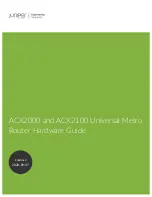
Features
4
Enterasys X-Pedition 2000 Getting Started Guide
•
Statistics
•
Management
Bridging
The XP-2000 provides the following types of high-speed bridging:
•
Address-based bridging – The XP-2000 performs this type of bridging by looking up the
destination address in an L2 lookup table on the expansion module that receives the bridge
packet from the network. The L2 lookup table indicates the exit port(s) for the bridged packet.
If the packet is addressed to the XP-2000’s own MAC address, the packet is routed rather than
bridged.
•
Flow-based bridging – The XP-2000 performs this type of bridging by looking up an entry in
the L2 lookup table containing both the source and destination addresses of the bridge packet.
Your choice of bridging method does not affect XP-2000 performance. However, address-based
bridging is more efficient because it requires fewer table entries while flow-based bridging provides
tighter management and control over bridged traffic.
The XP-2000 ports perform address-based bridging by default, but can be configured to perform
flow-based bridging instead of address-based bridging on a per-port basis. A port cannot be
configured to perform both types of bridging at the same time.
Port and Protocol VLANs
The XP-2000 supports the following types of Virtual LANs (VLANs):
•
Port-based VLANs – A port-based VLAN is a set of ports that comprises a Layer-2 broadcast
domain. The XP-2000 confines MAC-layer broadcasts to the ports in the VLAN on which the
broadcast originates. XP-2000 ports outside the VLAN do not receive the broadcast.
•
Protocol-based VLANs – A protocol-based VLAN is a named set of ports that comprises an
IP or IPX broadcast domain. The XP-2000 confines IP or IPX broadcasts to the ports within the
IP or IPX based VLAN. Protocol-based VLANs sometimes are called subnet VLANs or Layer-
3 VLANs.
You can include the same port in more than one VLAN, even in both port-based and protocol-based
VLANs. Moreover, you can define VLANs that span across multiple
XP-2000s. To simplify VLAN administration, the XP-2000 supports 802.1q trunk ports, which
allow you to use a single port to “trunk” traffic from multiple VLANs to another XP-2000 or switch
which supports 802.1q.
Routing
The XP-2000 provides high-speed routing for the following protocols:
Summary of Contents for X-Pedition 2000
Page 1: ...Getting Started Guide Revision Date 02 28 2003 2000 9032766 09 ...
Page 12: ...Contents xii Enterasys X Pedition 2000 Getting Started Guide ...
Page 16: ...Preface xvi Enterasys X Pedition 2000 Getting Started Guide ...
Page 38: ...Hardware Overview 22 Enterasys X Pedition 2000 Getting Started Guide ...
Page 58: ...Installing the Hardware 42 Enterasys Xpedition 2000 Getting Started Guide ...
Page 86: ...Index 70 Enterasys X Pedition 2000 Getting Started Guide ...
















































